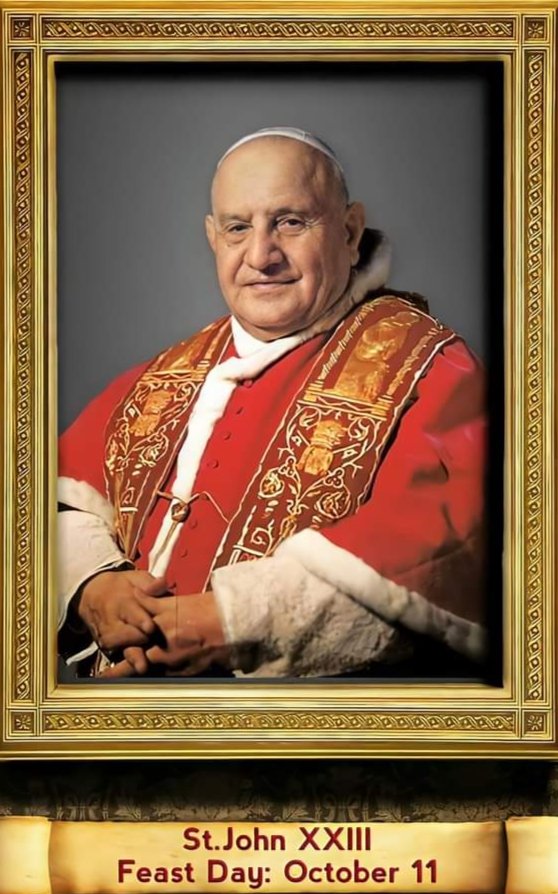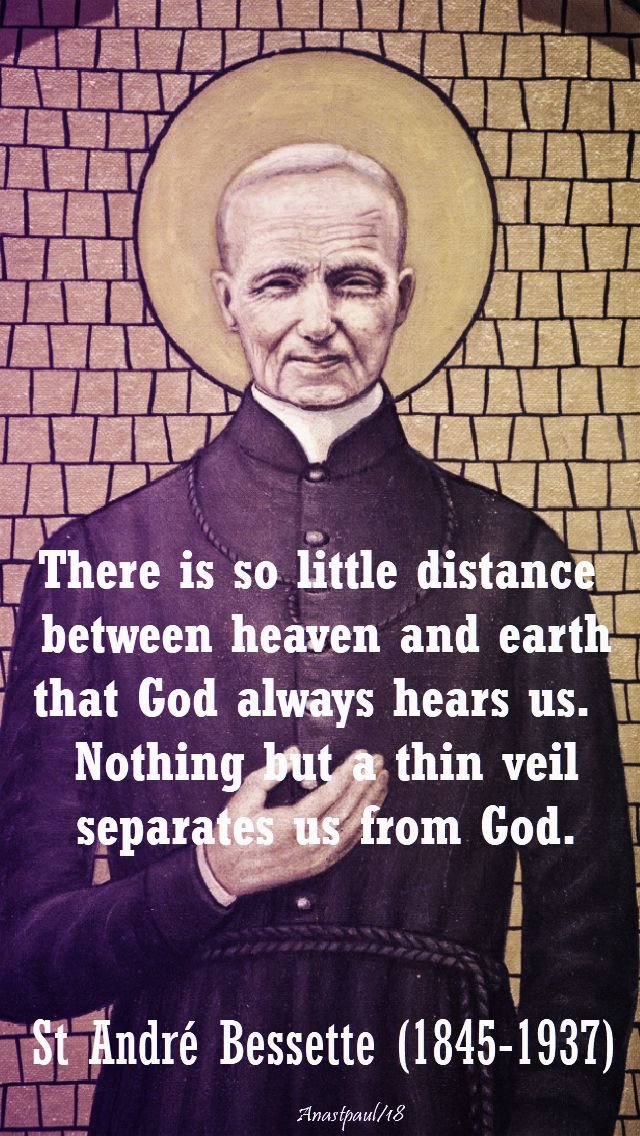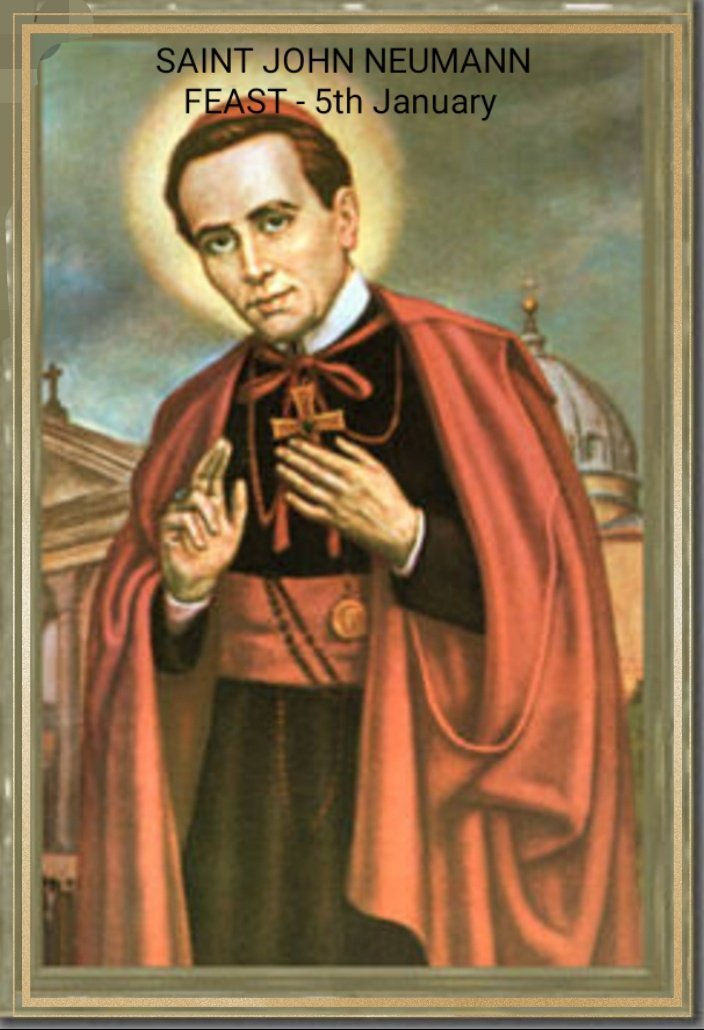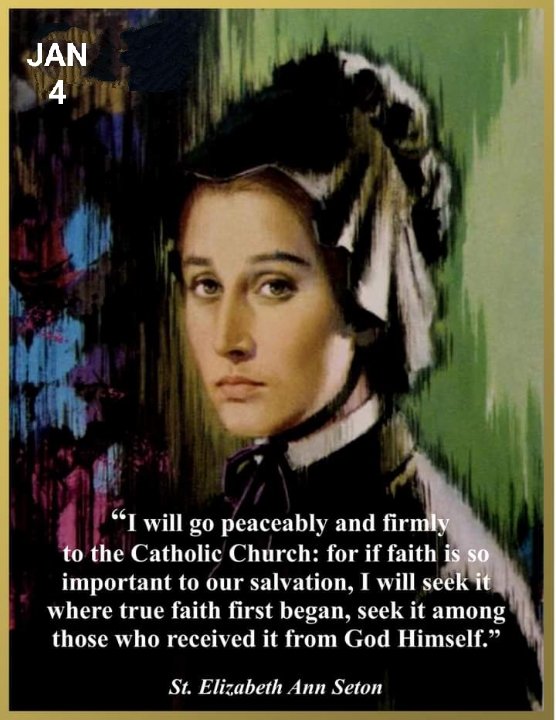FEAST OF SAINT JOHN XXIII, POPE, FORMER HEAD OF THE CHURCH
FEAST DAY – 11th OCTOBER
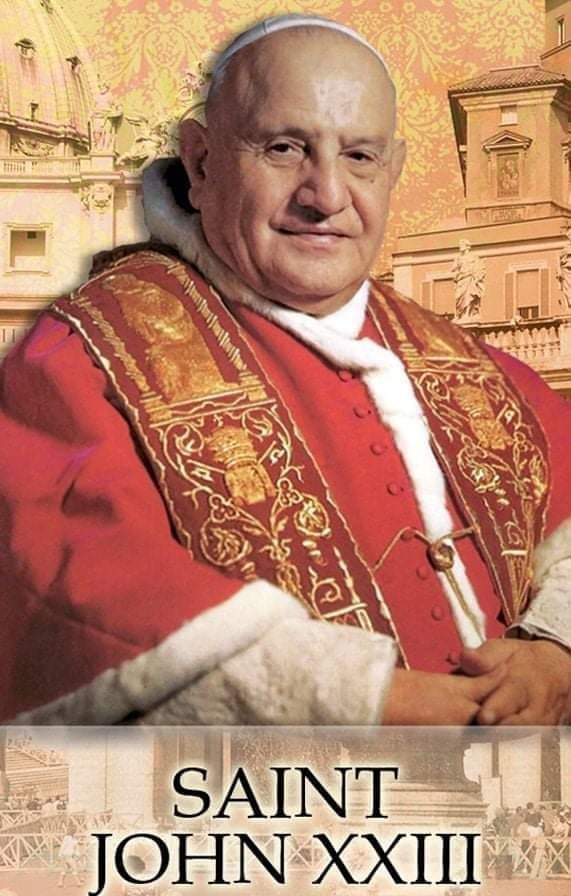
Pope John XXIII (25 November 1881 – 3 June 1963) was head of the Catholic Church and sovereign of the Vatican City State from 28 October 1958 until his death in 1963. Angelo Giuseppe Roncalli was one of thirteen children born to Marianna Mazzola and Giovanni Battista Roncalli in a family of sharecroppers who lived in Sotto il Monte, a village in the province of Bergamo, Lombardy.
He was ordained to the priesthood on 10 August 1904 and served in a number of posts, as nuncio in France and a delegate to Bulgaria, Greece and Turkey. In a consistory on 12 January 1953 Pope Pius XII made Roncalli a cardinal as the Cardinal-Priest of Santa Prisca in addition to naming him as the Patriarch of Venice. Roncalli was unexpectedly elected pope on 28 October 1958 at age 76 after 11 ballots.
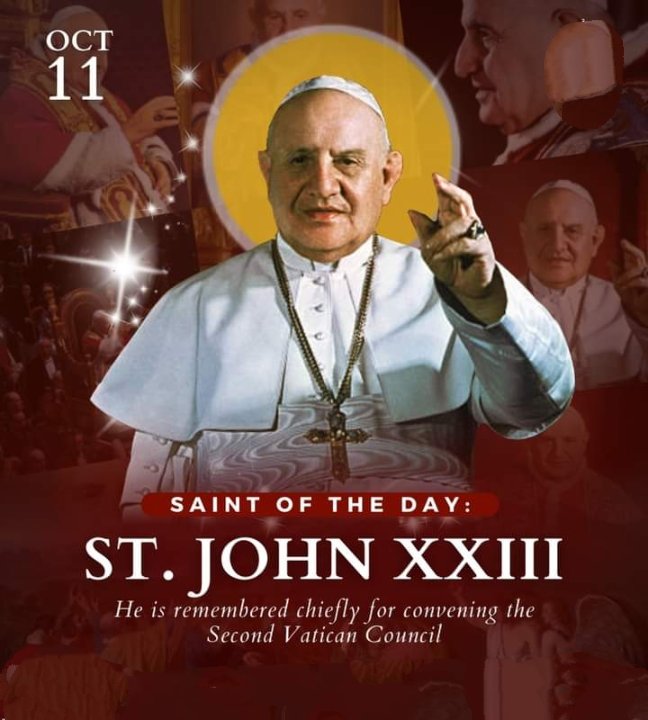
Pope John XXIII surprised those who expected him to be a caretaker pope by calling the historic Second Vatican Council (1962–1965), the first session opening on 11 October 1962. John XXIII made many passionate speeches during his pontificate. His views on equality were summed up in his statement, “We were all made in God’s image, and thus, we are all Godly alike.” He made a major impact on the Catholic Church, opening it up to dramatic unexpected changes promulgated at the Vatican Council and by his own dealings with other churches and nations.
In Italian politics, he prohibited bishops from interfering with local elections, and he helped the Christian Democracy to cooperate with the Italian Socialist Party. In international affairs, his “Ostpolitik” engaged in dialogue with the communist countries of Eastern Europe. He especially reached out to the Eastern Orthodox churches. His overall goal was to modernize the Church by emphasizing its pastoral role, and its necessary involvement with affairs of state.
He dropped the traditional rule of 70 cardinals, increasing the size to 85. He used the opportunity to name the first cardinals from Africa, Japan, and the Philippines. He promoted ecumenical movements in cooperation with other Christian faiths. In doctrinal matters, he was a traditionalist, but he ended the practice of automatically formulating social and political policies on the basis of old theological propositions.
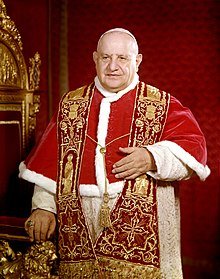
Blessed John XXIII, who will be made a saint April 27, is remembered by many for his warmth, simplicity, social conscience and sense of humor. Pope Francis, who will canonize “the Good Pope,” recalled his predecessor as being holy, patient and a man of courage, especially by calling the Second Vatican Council. Blessed John is pictured in his undated official portrait. (CNS photo/Catholic Press Photo) (March 24, 2014) See SAINTS -JXXIIIHUMOR March 24, 2014.
He did not live to see the Vatican Council to completion. His cause for canonization was opened on 18 November 1965 by his successor, Pope Paul VI, who declared him a Servant of God. On 5 July 2013, Pope Francis – bypassing the traditionally required second miracle – declared John XXIII a saint, based on his virtuous, model lifestyle, and because of the good which had come from his opening of the Second Vatican Council. He was canonized alongside Pope John Paul II on 27 April 2014. John XXIII today is affectionately known as the Good Pope.
Angelo Giuseppe Roncalli was born on 25 November 1881 in Sotto il Monte, a small country village in the Bergamo province of the Lombardy region of Italy. He was the eldest son of Giovanni Battista Roncalli (1854–1935) and his wife Marianna Giulia Mazzola (1855–1939), and fourth in a family of thirteen. Roncalli was nonetheless a descendant of an Italian noble family, albeit from a secondary and impoverished branch. The Roncallis maintained a vineyard and cornfields, and kept cattle.
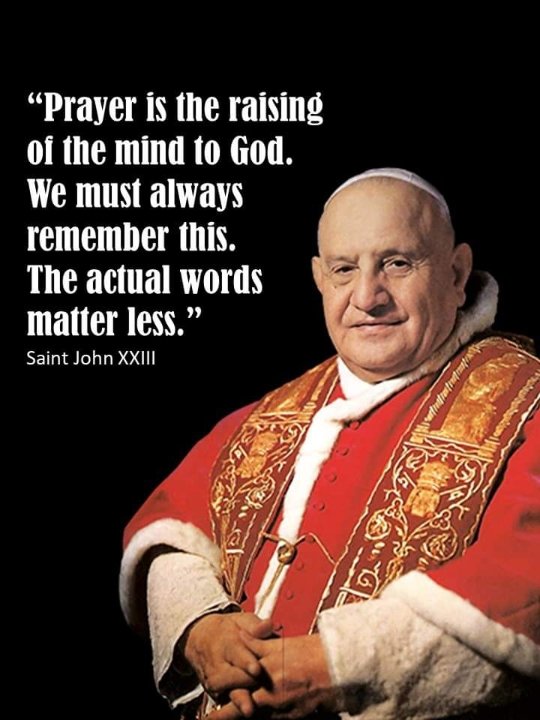
In 1889, Roncalli received both his First Communion and Confirmation at the age of 8. On 1 March 1896, Luigi Isacchi, the spiritual director of his seminary, enrolled him into the Secular Franciscan Order. He professed his vows as a member of that order on 23 May 1897. In 1904, Roncalli completed his doctorate in canon law and was ordained a priest in the Catholic Church of Santa Maria in Monte Santo in Piazza del Popolo in Rome on 10 August.
Shortly after that, while still in Rome, Roncalli was taken to Saint Peter’s Basilica to meet Pope Pius X. After this, he would return to his town to celebrate Mass for the Assumption. In 1905, Giacomo Radini-Tedeschi, the new Bishop of Bergamo, appointed Roncalli as his secretary. Roncalli worked for Radini-Tedeschi until the bishop’s death on 22 August 1914, two days after the death of Pope Pius X. Radini-Tedeschi’s last words to Roncalli were “Angelo, pray for peace”.
The death of Radini-Tedeschi had a deep effect on Roncalli. During this period Roncalli was also a lecturer in the diocesan seminary in Bergamo. During World War I, Roncalli was drafted into the Royal Italian Army as a sergeant, serving in the medical corps as a stretcher-bearer and as a chaplain. After being discharged from the army in early 1919, he was named spiritual director of the seminary.
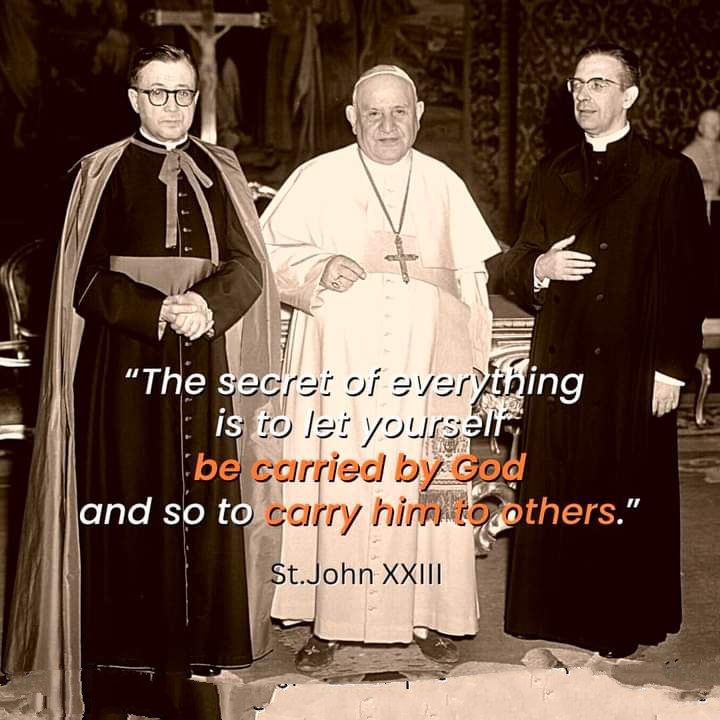
On 7 May 1921, Roncalli was appointed a Domestic Prelate of His Holiness, which gave him the title of Monsignor. On 6 November, he travelled to Rome where he was scheduled to meet the Pope. After their meeting, Pope Benedict XV appointed him as the Italian president of the Society for the Propagation of the Faith. Roncalli would recall Benedict XV as being the most sympathetic of the popes he had met.
In February 1925, the Cardinal Secretary of State Pietro Gasparri summoned him to the Vatican and informed him of Pope Pius XI’s decision to appoint him the Apostolic Visitor to Bulgaria (1925–1935). On 3 March, Pius XI also appointed him titular archbishop of Areopolis, Jordan. Roncalli was initially reluctant about a mission to Bulgaria, but he soon relented. His nomination as apostolic visitor was made official on 19 March. He was consecrated a bishop by Giovanni Tacci Porcelli in the church of San Carlo al Corso in Rome.
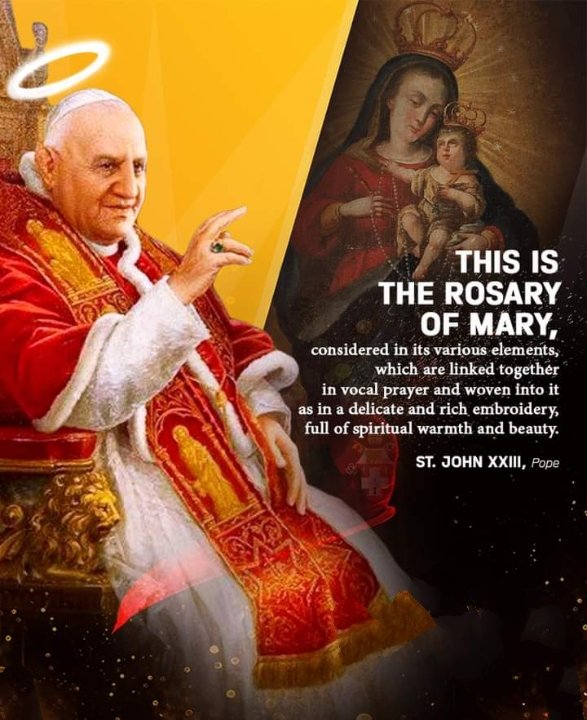
On 30 November 1934, he was appointed Apostolic Delegate to Turkey and Greece and titular archbishop of Mesembria, Bulgaria. He became known in Turkey’s predominantly Muslim society as “the Turcophile Pope”. He took up this post in 1935 using his office to help the Jewish underground in saving thousands of refugees in Europe, leading some to consider him to be a Righteous Gentile (see Pope John XXIII and Judaism). In 1935, he led Bulgarian pilgrims to Rome introducing them to Pope Pius XI on 14 October.
In February 1939, he received news from his sisters that his mother was dying. On 10 February 1939, Pope Pius XI died. Roncalli was unable to see his mother for the end as the death of a pontiff meant that he would have to stay at his post until the election of a new pontiff. Unfortunately, she died on 20 February 1939, during the nine days of mourning for the late Pius XI. He was sent a letter by Cardinal Eugenio Pacelli, and Roncalli later recalled that it was probably the last letter Pacelli sent until his election as Pope Pius XII on 2 March 1939.
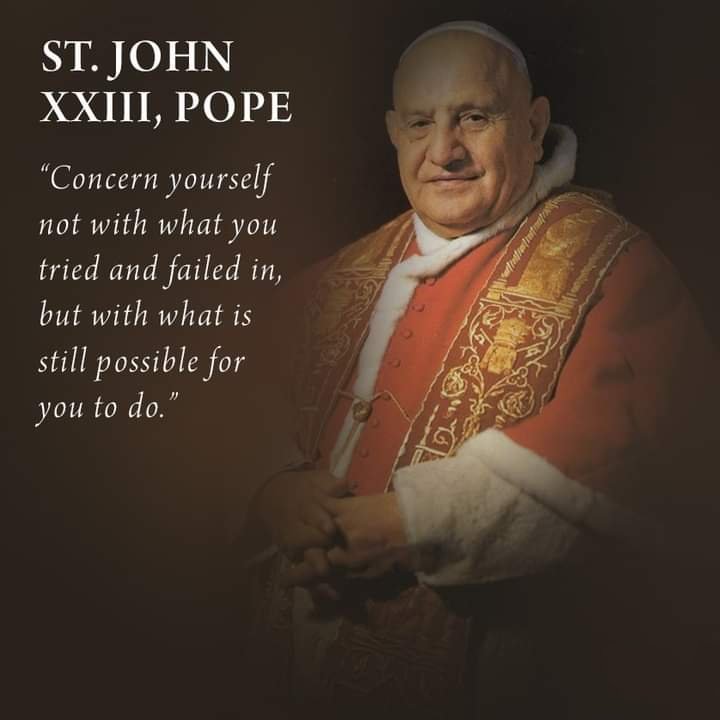
Roncalli expressed happiness that Pacelli was elected, and, on radio, listened to the coronation of the new pontiff. In 1939, Roncalli was made head of the Vatican Jewish Agency in Geneva. Roncalli remained in Bulgaria at the time that World War II commenced, optimistically writing in his journal in April 1939, “I don’t believe we will have a war”.
At the time that the war did in fact commence, he was in Rome, meeting with Pope Pius XII on 5 September 1939. In 1940, Roncalli was asked by the Vatican to devote more of his time to Greece; therefore, he made several visits there in January and May of that year. The same year, Roncalli departed as head of the Vatican Jewish Agency and migrated to Turkey. However, he still maintained close relations with the Jews and also intervened to convince Bulgaria’s King Boris III to cancel deportations of Greek Jews during the Nazi occupation of Greece.
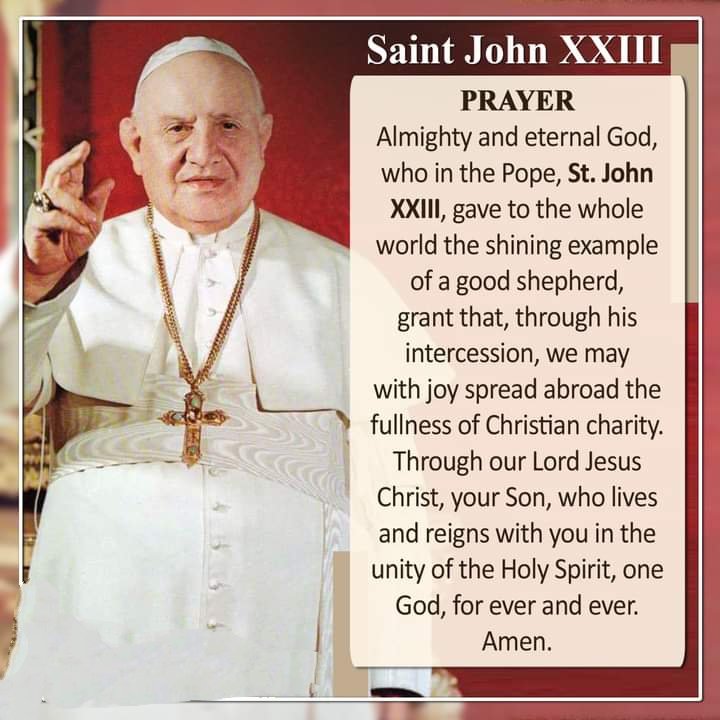
Following the death of Pope Pius XII on 9 October 1958, Roncalli watched the live funeral on his last full day in Venice on 11 October. His journal was specifically concerned with the funeral and the abused state of the late pontiff’s corpse. Roncalli left Venice for the conclave in Rome well aware that he was papabile, and after eleven ballots, was elected to succeed the late Pius XII, so it came as no surprise to him, though he had arrived at the Vatican with a return train ticket to Venice.
Many had considered Giovanni Battista Montini, the Archbishop of Milan, a possible candidate, but, although he was the archbishop of one of the most ancient and prominent sees in Italy, he had not yet been made a cardinal. Though his absence from the 1958 conclave did not make him ineligible – under Canon Law any Catholic male who is capable of receiving priestly ordination and episcopal consecration may be elected – the College of Cardinals usually chose the new pontiff from among the Cardinals attending the papal conclave.
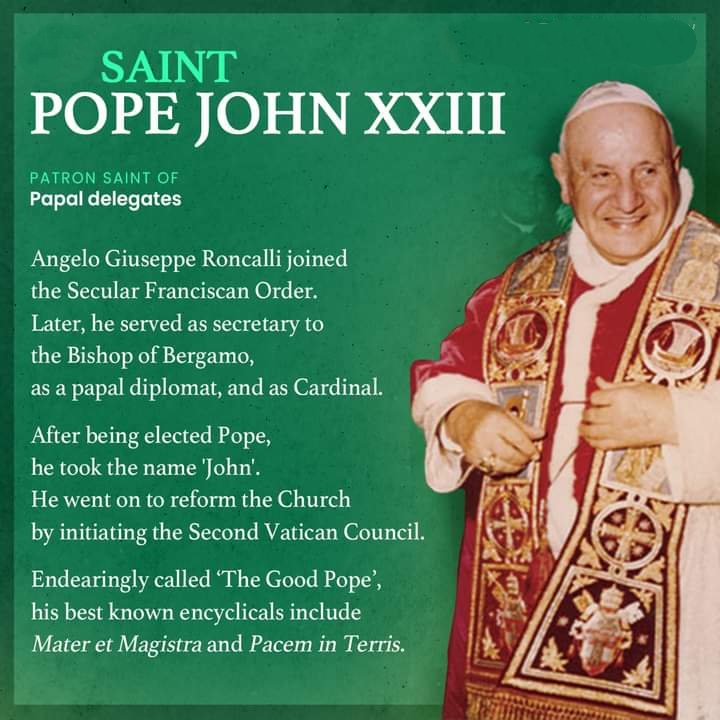
At the time, as opposed to modern practice, the participating Cardinals did not have to be below age 80 to vote, there were few Eastern-rite Cardinals, and some Cardinals were just priests at the time of their elevation. Roncalli was summoned to the final ballot of the conclave at 4:00 pm. He was elected pope at 4:30 pm with a total of 38 votes. After the long pontificate of Pope Pius XII, the cardinals chose a man who – because of his advanced age – would be a short-term or “stop-gap” pope.
They wished to choose a candidate who would do little during the new pontificate. Upon his election, Cardinal Eugène Tisserant asked him the ritual questions of whether he would accept and if so, what name he would take for himself. Roncalli gave the first of his many surprises when he chose “John” as his regnal name. Roncalli’s exact words were “I will be called John”. This was the first time in over 500 years that this name had been chosen; previous popes had avoided its use since the time of the Antipope John XXIII during the Western Schism several centuries before.
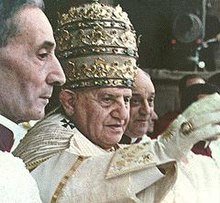
His coronation took place on 4 November 1958, on the feast of Saint Charles Borromeo, and it occurred on the central loggia of the Vatican. He was crowned with the 1877 Palatine Tiara. His coronation ran for the traditional five hours. In John XXIII’s first consistory on 15 December of that same year, Montini was created a cardinal and would become John XXIII’s successor in 1963, taking the name of Paul VI. That consistory was notable for being the first to expand the Sacred College membership beyond the then-traditional 70.
John XXIII was an advocate for human rights which included the unborn and the elderly. He wrote about human rights in his encyclical Pacem in terris. He wrote, “Man has the right to live. He has the right to bodily integrity and to the means necessary for the proper development of life, particularly food, clothing, shelter, medical care, rest, and, finally, the necessary social services. In consequence, he has the right to be looked after in the event of ill health; disability stemming from his work; widowhood; old age; enforced unemployment; or whenever through no fault of his own he is deprived of the means of livelihood.”
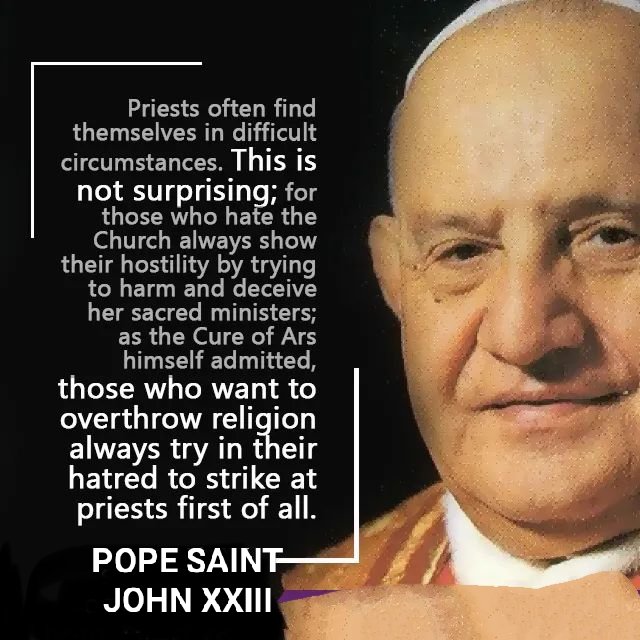
Pope John XXIII was the last pope to use full papal ceremony, some of which was abolished after Vatican II, while the rest fell into disuse. His papal coronation ran for the traditional five hours (Pope Paul VI, by contrast, opted for a shorter ceremony, while later popes declined to be crowned). Pope John XXIII, like his predecessor Pius XII, chose to have the coronation itself take place on the balcony of Saint Peter’s Basilica, in view of the crowds assembled in Saint Peter’s Square below.
He wore a number of papal tiaras during his papacy. On the most formal of occasions would he don the 1877 Palatine tiara he received at his coronation, but on other occasions, he used the 1922 tiara of Pope Pius XI, which was used so often that it was associated with him quite strongly. The people of Bergamo gave him an expensive silver tiara, but he requested that the number of jewels used be halved and that the money be given to the poor.
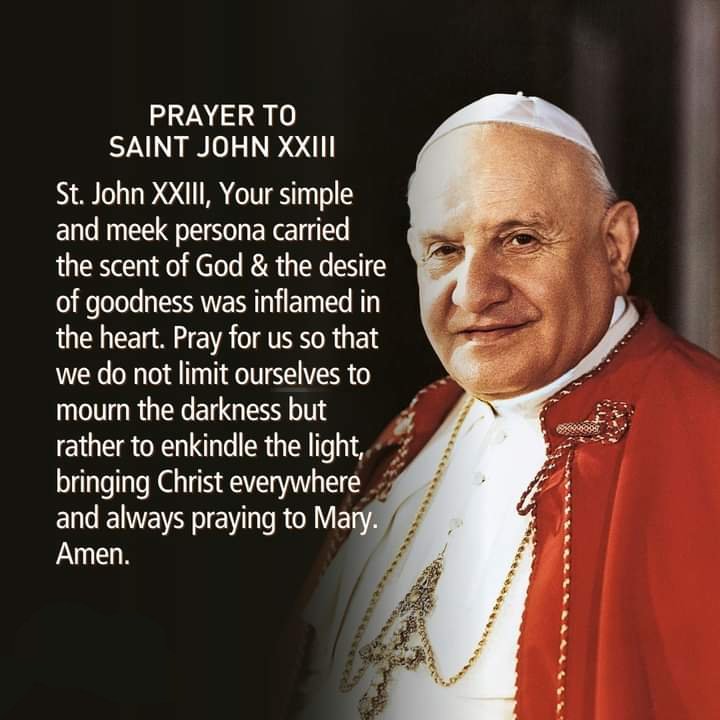
Maintaining continuity with his predecessors, John XXIII continued the gradual reform of the Roman liturgy, and published changes that resulted in the 1962 Roman Missal, the last typical edition containing the Tridentine Mass established in 1570 by Pope Pius V at the request of the Council of Trent.
John XXIII died of peritonitis caused by a perforated stomach at 19:49 local time on 3 June 1963 at the age of 81, ending a historic pontificate of four years and seven months. He died just as a Mass for him finished in Saint Peter’s Square below, celebrated by Luigi Traglia. After he died, his brow was ritually tapped to see if he was dead, and those with him in the room said prayers.
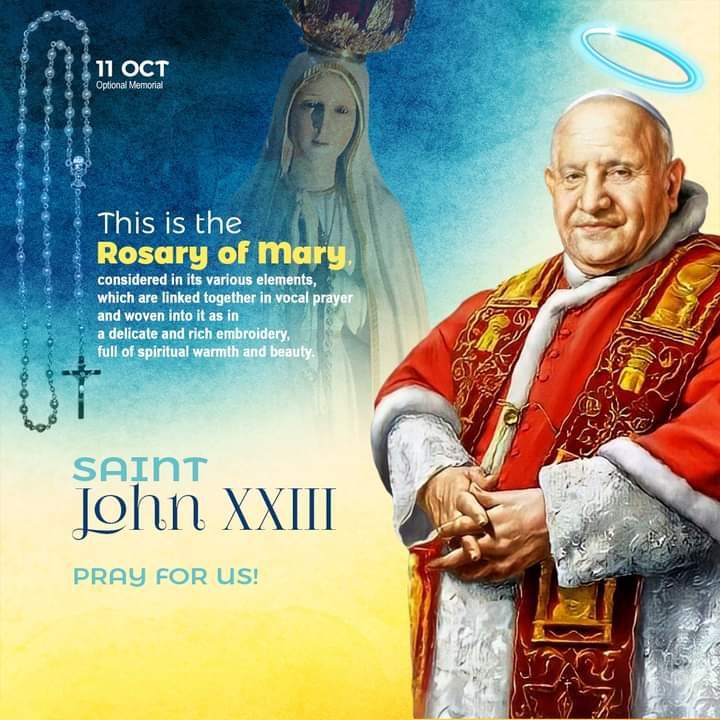
Then the room was illuminated, thus informing the people of what had happened. The Italian government announced three days of mourning with flags half-masted and the closure of offices and schools. Spain announced ten days of mourning with flags half-masted; Philippines announced nine days of mourning with flags half-masted; Paraguay and Guatemala announced three days of mourning; Republic of the Congo declared one day of mourning.
He was buried on 6 June in the Vatican grottos. Two wreaths, placed on the two sides of his tomb, were donated by the prisoners of the Regina Coeli prison and the Mantova jail in Verona. On 22 June 1963, one day after his friend and successor Pope Paul VI was elected, the latter prayed at his tomb. John XXIII’s tomb is located near the tombs of Pope Pius X and Pope John Paul II.
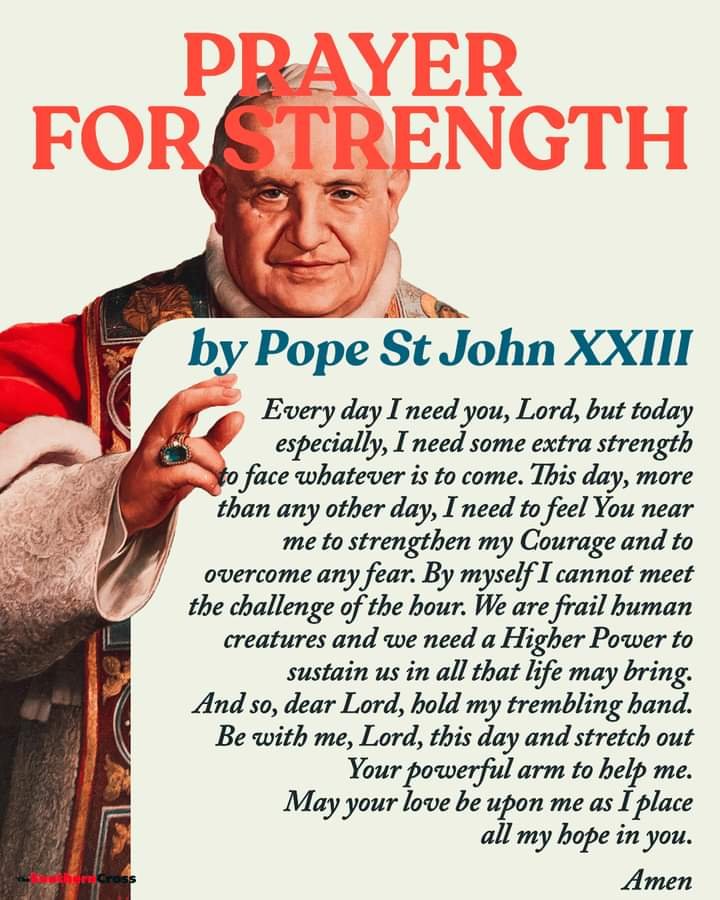
On 3 December 1963, US President Lyndon B. Johnson posthumously awarded him the Presidential Medal of Freedom, the United States’ highest civilian award, in recognition of the good relationship between Pope John XXIII and the United States of America. The citation for the medal reads:
His Holiness Pope John XXIII, dedicated servant of God. He brought to all citizens of the planet a heightened sense of the dignity of the individual, of the brotherhood of man, and of the common duty to build an environment of peace for all human kind.
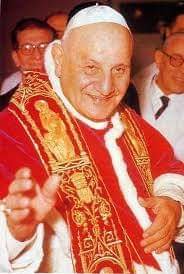
He was known affectionately as the “Good Pope”. His cause for canonization was opened under Pope Paul VI during the final session of the Second Vatican Council on 18 November 1965, along with the cause of Pope Pius XII. On 3 September 2000, John XXIII was declared “Blessed” alongside Pope Pius IX by Pope John Paul II, the penultimate step on the road to sainthood, after a miracle of curing an ill woman was discovered.
He was the first pope since Pope Pius X to receive this honour. Following his beatification, his body was moved from its original burial place in the grottoes below the Vatican to the altar of St. Jerome and displayed for the veneration of the faithful. At the time, the body was observed to be extremely well preserved – a condition which the Church ascribes to embalming and the lack of air flow in his sealed triple coffin rather than a miracle.

When John XXIII’s body was moved in 2001, it was once again treated to prevent deterioration. The original vault above the floor was removed and a new one built beneath the ground; it was here that the body of Pope John Paul II was entombed from 9 April 2005 to April 2011, before being moved for his beatification on 1 May 2011. The 50th anniversary of his death was celebrated on 3 June 2013 by Pope Francis, who visited his tomb and prayed there, then addressing the gathered crowd and spoke about the late pope.
The people that gathered there at the tomb were from Bergamo, the province where the late pope came from. A month later, on 5 July 2013, Francis approved Pope John XXIII for canonization, along with Pope John Paul II without the traditional second miracle required. Instead, Francis based this decision on John XXIII’s merits for the Second Vatican Council. On Sunday, 27 April 2014, John XXIII and Pope John Paul II were declared saints on Divine Mercy Sunday.

The date assigned for the liturgical celebration of John XXIII is not 3 June, the anniversary of his death as would be usual, but 11 October, the anniversary of his opening of the Second Vatican Council.[95] He is also commemorated in the Anglican Church of Canada, the Evangelical Lutheran Church in America, and some other organizations with a feast day of 3 June or 4 June.
“Pope Roncalli helped place the vocation to holiness at the very core of Christian life. We can go to his intercession today to beseech God that all men and women may take deeply to heart this truth proclaimed by Vatican II: that sanctity is attainable by all Christians.” – Bishop Javier Echevarría
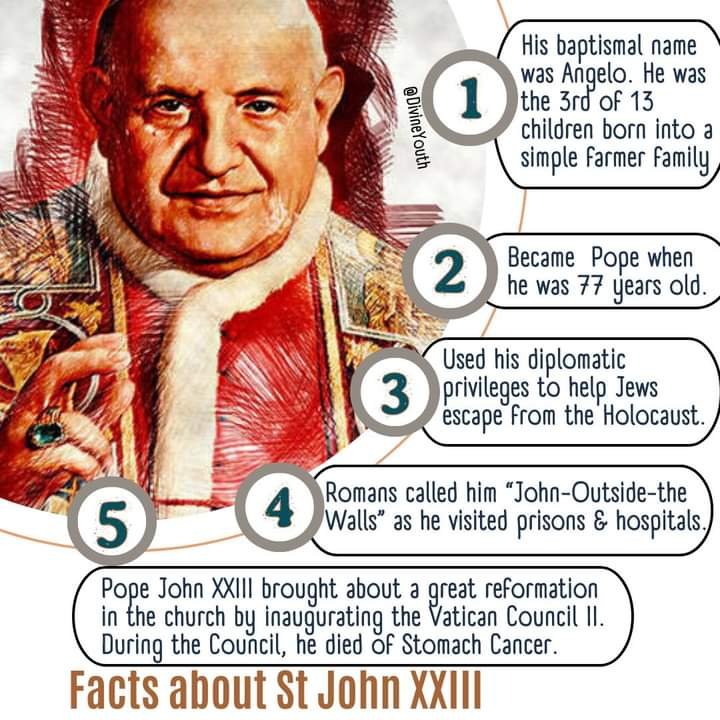
“This is the rosary of Mary, considered in its various elements, which are linked together in vocal prayer and woven into it as in a delicate and rich embroidery, full of spiritual warmth and beauty.” – Pope John XXIII
PRAYER
Almighty and eternal God, who in the Pope, Saint John XXIII, gave to the whole world the shining example of a good shepherd, grant that, through his intercession, we may with joy spread abroad the fullness of Christian charity. Through our Lord Jesus Christ, your Son, who lives and reigns with you in the unity of the Holy Spirit, one God, for ever and ever. Amen!

Our Lady of Fatima, pray for us!
Pope Saint John XXIII, pray for us!

